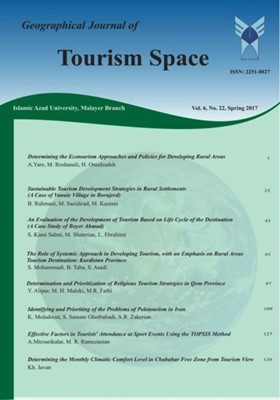-
-
List of Articles
-
Open Access Article
1 - Determining the Ecotourism Approaches and Policies for Developing Rural Areas
-
Open Access Article
2 - Sustainable Tourism Development Strategies in Rural Settlements (A Case of Vanaie Village in Borujerd)
-
Open Access Article
3 - An Evaluation of the Development of Tourism Based on Life Cycle of the Destination (A Case Study of Boyer Ahmad)
-
Open Access Article
4 - The Role of Systemic Approach in Developing Tourism, with an Emphasis on Rural Areas Tourism Destination: Kurdistan Province
-
Open Access Article
5 - Determination and Prioritization of Religious Tourism Strategies in Qom Province
-
Open Access Article
6 - Identifying and Prioriting of the Problems of Polotourism in Iran
Kiyumars Moladoost Sahar Samani Ghotbabadi Alireza Zakerian -
Open Access Article
7 - Effective Factors in Tourists’ Attendance at Sport Events Using the TOPSIS Method
-
Open Access Article
8 - Determining the Monthly Climatic Comfort Level in Chabahar Free Zone
-
The rights to this website are owned by the Raimag Press Management System.
Copyright © 2021-2025







